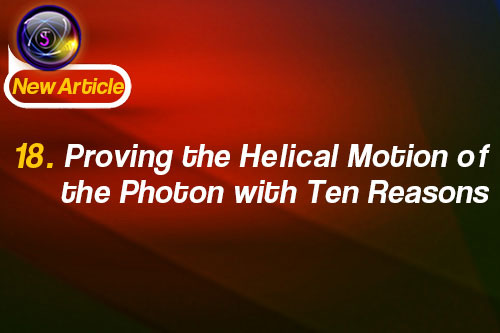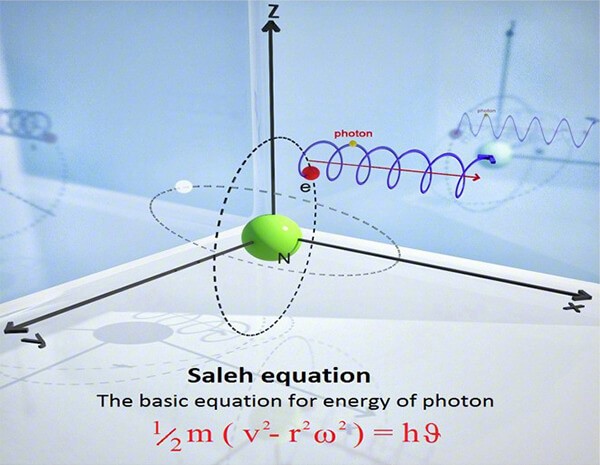

Abstract. In the Thomas Young experiment, interference patterns are observed and to justify them, they are considered light as a wave. But an Electron whose rest-mass has been proven to be constant also has an interference pattern in Young’s double-slit experiment. Therefore, it seems that existence of interference patterns is related to the motion of particle not the nature of it. In this paper, we are going to introduce a helical motion for photon and prove it with 10 great reasons. On the other hand, we will show that the photon has a constant rest-mass.
I. IntroductionThe studies of scientists including Maxwell in the field of electromagnetism showed that visible light is just a tiny part of a larger radiant spectrum. Scientists have been studying hard to find out how the light travels from the light source to our eyes. Some believed that it would probably move in the form of a wave but the others thought that light was actually composed of particles that move in space.
Isaac Newton, based on his experiments liked the second theory. But Newton's theory was rejected later. To his theory’s rejection, one of the most famous experiments is the one performed by Thomas Young in 1801 [1].
In the second half of the nineteenth century, physicists studied why some materials absorb and emit electromagnetic radiation better than some other materials. In 1900, Max Planck proposed the theory of quantum energy that could justify one of the problems of physicists of that time. He explained the relationship between black body temperature and the amount of electromagnetic radiation [2].
It was true that the photoelectric effect experiment confirmed Planck's quantum theory but created a new problem in the wave theory of light. This experiment can only be justified by considering the light as a particle. A few years later, Einstein for explaining the photoelectric experiment, presented the concept of "wave-particle duality of light" [3].
II. ReasonsThe reason for not accepting the constant rest-mass for photons and believing in its wave-like state was the famous experiment of Thomas Young. In this experiment, interference patterns are observed and to justify them, they are considered light as a wave[1]. But the question is, why does an Electron whose rest-mass has been proven to be constant also has an interference pattern in Young’s double-slit experiment? Therefore, it seems that existence of interference patterns is related to the motion of particle not the nature of it.
In the wave-particle duality theory, the wave motion pattern considered for the photon's motion is a sine wave. And as you know, a sine wave is equivalent to the shadow of a circular motion (helical motion) on a two-dimensional diagram. Therefore, Saleh theory has the Correspondence principle and in its two-dimensional state, it reaches the wave-particle theory [4,5]. In other words, wave- particle theory is a special case or an incomplete two- dimensional view of the larger set of Saleh theory (Figure 1).

In non-material mediums, there is no sinusoidal motion. The rotational motion around the central axis, simultaneously with the linear motion, is common in many phenomena, such as the real motion of the Earth around the Sun in galaxy or a bullet coming out of the barrel of a gun [6].
According to the wave-particle duality theory, the mass of a blue photon is assumed to be about twice the mass of a red photon. On the other hand, the energy of blue light is estimated to be higher than the energy of red light due to its higher frequency. Whereas visually and sensually, the red light is heavier, stronger and warmer than the blue light. But in Saleh theory, the red light, due to having a larger gyroradius than blue one, has more rotational energy. Therefore our eyes feel the red light warmer than the blue.
The eyes of human perceive the light only when the ray of light enters the eye head-on. On the other hand, as you know according to the wave-particle duality theory, with changing the frequency the different colors are created. If we look at a light ray head-on, we will see a point in front of us moving up and down, and we will not be able to see any difference between the blue or red light with different wavelengths. But in Saleh Theory, the difference in colors of the light is due to their difference in the gyroradius of their photons. Therefore, the photons of red light and the blue one that come from the front side to our eye have different rotation radiuses, and our eyes perceive this difference in radius and perceive it as two different colors [4,5].
Experiments show that amount of electrical energy production in solar cells, have a direct relation to the wavelength of the entered light. Thus, in the visible light spectrum, the red light has a higher output than the blue light. But as mentioned, according to the wave-particle theory, the red light is considered to have lower energy than blue one. However in Saleh theory, the red light photons, due to their larger gyroradius, have more rotational energy than the blue light photons. Therefore, it is natural for the red light photons to show better efficiency in solar cells [4,5].
Visibility of red light in longer distances has become a reason to use as hazard and warning lights in different places. However, in wave-particle theory the energy of the red light photons are considered to be less than that of blue light. But in Saleh theory, the red light photon has larger gyroradius and as a result has more rotational energy than blue light [4,5].
The experiments have demonstrated that the evanescent of the red light is more than the blue light. However, according to the wave-particle duality theory, the red light photons with less energy than blue light should have a lower Evanescent. But in Saleh theory, the red light photons have larger radius of rotation than the blue light, and as a result they will have a greater penetrating to the clad of fiber[4].
According to wave-particle theory, it is believed that when two different photons like red and green ones collide with each other, a new photon (yellow) will be created. The mass of which is not the sum of the two original masses but it's their average. And more interestingly, this new photon has average energy and not total energy. Furthermore, without any loss or waste of energy, in less than a thousandth of a second, this newly created mass is converted back into exactly the same two original masses, namely the green and red light photons with their own energy. Aside from violating the conservation law of linear momentum, this event is technically impossible in physics. But in Saleh theory photons of red, green and yellow are all possessing mass and equal total energy, but different radiuses of rotation. Therefore, at the point of intersection, we will have two photons, which the mass of each is equal to the mass of the red and green photons, and there is no change in mass [5].
According to Louis de Broglie's theory, all matters have dual nature, and this is not merely limited to the light. For example, Electrons that have constant mass have wave-like nature at the same time. Therefore, it is not impossible for a photon to have a fixed mass. And this is the point that is considered in Saleh theory.
III. Results and DiscussionThe existence of interference patterns is related to the motion of particle not the nature of it. In this paper, we have introduced a helical motion for photon and proved it with 10 great reasons. On the other hand, we have showed that the photon has a constant rest-mass.
Therefore, based on Saleh Theory photon is a particle with a constant mass that traverses in a helical trajectory. In this theory the wave-particle duality and all other properties of light could be explained easily.
VI. References[1] Young, Thomas. "Experimental demonstration of the general law of the interference of light." Philosophical Transactions of the Royal society of London 94.1804 (1804): 1.
[2] Hentschel, Klaus. Photons: The history and mental models of light quanta. Springer, 2018.
[3] Millikan, Robert A. "A Direct Determination of" h."." Physical Review 4.1 (1914): 73.